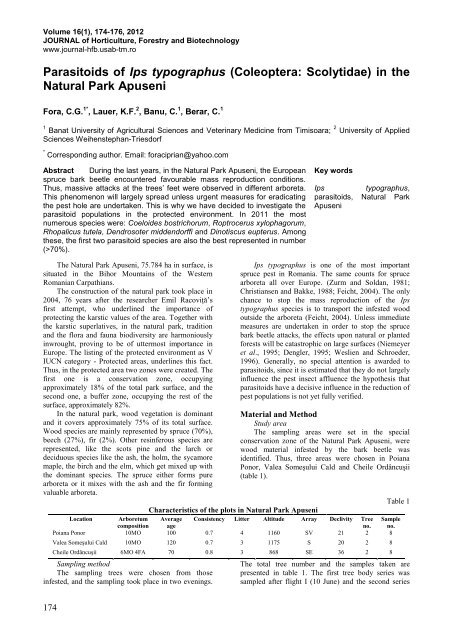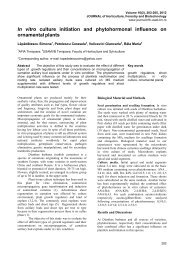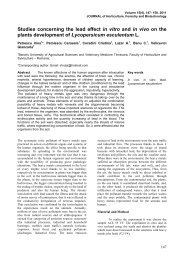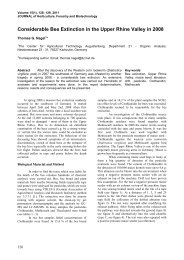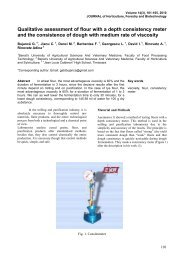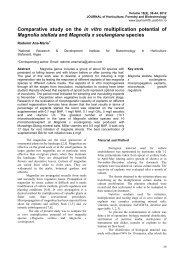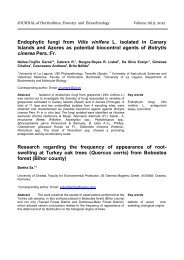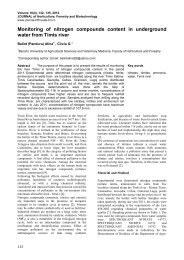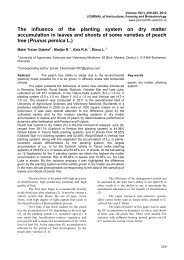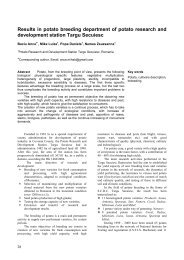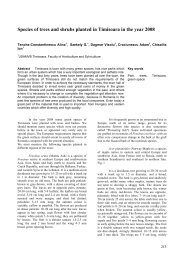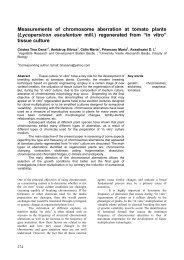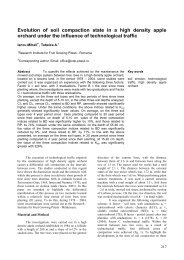Parasitoids of Ips typographus (Coleoptera: Scolytidae) - Journal of ...
Parasitoids of Ips typographus (Coleoptera: Scolytidae) - Journal of ...
Parasitoids of Ips typographus (Coleoptera: Scolytidae) - Journal of ...
Create successful ePaper yourself
Turn your PDF publications into a flip-book with our unique Google optimized e-Paper software.
Volume 16(1), 174-176, 2012<br />
JOURNAL <strong>of</strong> Horticulture, Forestry and Biotechnology<br />
www.journal-hfb.usab-tm.ro<br />
<strong>Parasitoids</strong> <strong>of</strong> <strong>Ips</strong> <strong>typographus</strong> (<strong>Coleoptera</strong>: <strong>Scolytidae</strong>) in the<br />
Natural Park Apuseni<br />
Fora, C.G. 1* , Lauer, K.F. 2 , Banu, C. 1 , Berar, C. 1<br />
1 Banat University <strong>of</strong> Agricultural Sciences and Veterinary Medicine from Timisoara; 2 University <strong>of</strong> Applied<br />
Sciences Weihenstephan-Triesdorf<br />
* Corresponding author. Email: foraciprian@yahoo.com<br />
Abstract During the last years, in the Natural Park Apuseni, the European<br />
spruce bark beetle encountered favourable mass reproduction conditions.<br />
Thus, massive attacks at the trees’ feet were observed in different arboreta.<br />
This phenomenon will largely spread unless urgent measures for eradicating<br />
the pest hole are undertaken. This is why we have decided to investigate the<br />
parasitoid populations in the protected environment. In 2011 the most<br />
numerous species were: Coeloides bostrichorum, Roptrocerus xylophagorum,<br />
Rhopalicus tutela, Dendrosoter middendorffi and Dinotiscus eupterus. Among<br />
these, the first two parasitoid species are also the best represented in number<br />
(>70%).<br />
The Natural Park Apuseni, 75.784 ha in surface, is<br />
situated in the Bihor Mountains <strong>of</strong> the Western<br />
Romanian Carpathians.<br />
The construction <strong>of</strong> the natural park took place in<br />
2004, 76 years after the researcher Emil Racoviţă’s<br />
first attempt, who underlined the importance <strong>of</strong><br />
protecting the karstic values <strong>of</strong> the area. Together with<br />
the karstic superlatives, in the natural park, tradition<br />
and the flora and fauna biodiversity are harmoniously<br />
inwrought, proving to be <strong>of</strong> uttermost importance in<br />
Europe. The listing <strong>of</strong> the protected environment as V<br />
IUCN category - Protected areas, underlines this fact.<br />
Thus, in the protected area two zones were created. The<br />
first one is a conservation zone, occupying<br />
approximately 18% <strong>of</strong> the total park surface, and the<br />
second one, a buffer zone, occupying the rest <strong>of</strong> the<br />
surface, approximately 82%.<br />
In the natural park, wood vegetation is dominant<br />
and it covers approximately 75% <strong>of</strong> its total surface.<br />
Wood species are mainly represented by spruce (70%),<br />
beech (27%), fir (2%). Other resinferous species are<br />
represented, like the scots pine and the larch or<br />
deciduous species like the ash, the holm, the sycamore<br />
maple, the birch and the elm, which get mixed up with<br />
the dominant species. The spruce either forms pure<br />
arboreta or it mixes with the ash and the fir forming<br />
valuable arboreta.<br />
174<br />
Key words<br />
<strong>Ips</strong> <strong>typographus</strong>,<br />
parasitoids, Natural Park<br />
Apuseni<br />
<strong>Ips</strong> <strong>typographus</strong> is one <strong>of</strong> the most important<br />
spruce pest in Romania. The same counts for spruce<br />
arboreta all over Europe. (Zurm and Soldan, 1981;<br />
Christiansen and Bakke, 1988; Feicht, 2004). The only<br />
chance to stop the mass reproduction <strong>of</strong> the <strong>Ips</strong><br />
<strong>typographus</strong> species is to transport the infested wood<br />
outside the arboreta (Feicht, 2004). Unless immediate<br />
measures are undertaken in order to stop the spruce<br />
bark beetle attacks, the effects upon natural or planted<br />
forests will be catastrophic on large surfaces (Niemeyer<br />
et al., 1995; Dengler, 1995; Weslien and Schroeder,<br />
1996). Generally, no special attention is awarded to<br />
parasitoids, since it is estimated that they do not largely<br />
influence the pest insect affluence the hypothesis that<br />
parasitoids have a decisive influence in the reduction <strong>of</strong><br />
pest populations is not yet fully verified.<br />
Material and Method<br />
Study area<br />
The sampling areas were set in the special<br />
conservation zone <strong>of</strong> the Natural Park Apuseni, were<br />
wood material infested by the bark beetle was<br />
identified. Thus, three areas were chosen in Poiana<br />
Ponor, Valea Someşului Cald and Cheile Ordâncuşii<br />
(table 1).<br />
Table 1<br />
Characteristics <strong>of</strong> the plots in Natural Park Apuseni<br />
Location Arboretum Average Consistency Litter Altitude Array Declivity Tree Sample<br />
composition age<br />
no. no.<br />
Poiana Ponor 10MO 100 0.7 4 1160 SV 21 2 8<br />
Valea Someşului Cald 10MO 120 0.7 3 1175 S 20 2 8<br />
Cheile Ordâncuşii 6MO 4FA 70 0.8 3 868 SE 36 2 8<br />
Sampling method<br />
The sampling trees were chosen from those<br />
infested, and the sampling took place in two evenings.<br />
The total tree number and the samples taken are<br />
presented in table 1. The first tree body series was<br />
sampled after flight I (10 June) and the second series
after flight II (27 July). From each tree 4 infested body<br />
samples were taken. Each spruce body measured 1 m<br />
in length and 24-28 cm in diameter, since it is a known<br />
fact that <strong>Ips</strong> <strong>typographus</strong> prefer bodies larger than 22<br />
cm in diameter (Zurm, 1985). Thus, in both series I and<br />
II 12 infested bodies were sampled. The tree bodies<br />
were numbered, introduced in collectors and set in<br />
three locations near the sampling areas (Padiş, Doda<br />
Pilii, Casa de Piatră).<br />
Collectors<br />
The collectors (figure 1) are made from PE type<br />
transparent pipes, with 30 cm in diameter and 1 m in<br />
length, placed vertically. At their inferior end the<br />
collectors have a broad cone which at its base unloads<br />
in an insect collecting recipient.<br />
Fig. 1. Collectors for insects (Natural Park<br />
Apuseni/Doda Pilii)<br />
On their superior side, the collectors have a cloth<br />
which allows inside ventilation but does not allow the<br />
insects to exit. Once in 7 days the insects are collected<br />
in plastic recipients, they are numbered and dated. The<br />
last verifications were carried out in 19.09.<br />
Species identification<br />
The samples were analysed in the forest<br />
Entomology laboratory <strong>of</strong> the Faculty for Horticulture<br />
and Forestry <strong>of</strong> Timişoara, from the point <strong>of</strong> view <strong>of</strong><br />
the species composition and a quantitative point <strong>of</strong><br />
view.<br />
Results and Discussions<br />
During the three observation months, 5 parasitoid<br />
species <strong>of</strong> the <strong>Ips</strong> <strong>typographus</strong> beetle could be<br />
identified (figure 2): Coeloides bostrichorum<br />
(Hymenoptera: Braconidae), Dendrosoter middendorffi<br />
(Hymenoptera: Braconidae), Roptrocerus<br />
xylophagorum (Hymenoptera: Pteromalidae),<br />
Rhopalicus tutela (Hymenoptera: Pteromalidae) and<br />
Dinotiscus eupterus (Hymenoptera: Pteromalidae). All<br />
species identified in the spruce stands within the<br />
protected Apuseni area were identified in resinferous<br />
forests by other authors as well (Weslien, 1992; Feicht,<br />
2006).<br />
The first two species which, by the by, represented<br />
72.20% (figure 2) <strong>of</strong> the total number <strong>of</strong> captured<br />
parasitoids were Coeloides bostrichorum (45.99%) and<br />
Roptrocerus xylophagorum (26.21%). Less represented<br />
were Rhopalicus tutela (12.93%) and Dendrosoter<br />
middendorffi (9.73%), while Dinotiscus eupterus only<br />
represented 5.14%. On all three locations, Coeloides<br />
bostrichorum and Roptrocerus xylophagorum were<br />
dominant species and thus the most important ones.<br />
This is something we cannot say about the other 3<br />
species, which together amounted to less than 30% <strong>of</strong><br />
the total captures.<br />
The parasitoids Coeloides bostrichorum and<br />
Roptrocerus xylophagorum were most frequently<br />
encountered in all wood samples from the collectors,<br />
both in sample series I and II. The parasitoid<br />
Rhopalicus tutela was found in 58% <strong>of</strong> the series I<br />
samples and in 83% <strong>of</strong> the series II samples.<br />
Dendrosoter middendorffi was found in 50% <strong>of</strong> the<br />
series I samples and 25% <strong>of</strong> the series II samples.<br />
Dinotiscus eupterus was found in 25% <strong>of</strong> the series I<br />
samples and in 33% <strong>of</strong> the series II samples.<br />
The largest parasitoid number was registered in<br />
Vale Someşului Cald, where the host species, <strong>Ips</strong><br />
<strong>typographus</strong>, presented the largest numbers as well,<br />
thus providing a better food source. Where the host<br />
insect populations were smaller, the parasitoid number<br />
was also smaller (Cheile Ordâncuşii). This fact shows a<br />
certain connection between the beetle and the<br />
parasitoid population level.<br />
If with the series I samples from the collectors the<br />
numbered <strong>of</strong> the captured parasitoids showed a<br />
ascending trend, a peak and then descended, we cannot<br />
say the same about the series II. With series II, the<br />
parasitoid number was larger than with series I, but the<br />
number had a descending trend from the first to the last<br />
captures.<br />
During the entire observation period we were not<br />
able to identify a reduction <strong>of</strong> the mass <strong>Ips</strong><br />
<strong>typographus</strong> species reproduction caused by its<br />
parasitoids.<br />
175
176<br />
100%<br />
80%<br />
60%<br />
40%<br />
20%<br />
0%<br />
17.6. 21.6. 28.6. 5.7. 12.7. 19.7. 26.7. 1.8. 8.8. 15.8. 22.8. 29.8. 5.9. 12.9. 19.9. Total<br />
Coeloides bostrichorum Roptrocerus xylophagorum Rhopalicus tutela Dendrosoter middendorffi Dinotiscus eupterus<br />
Fig. 2. Specific relative abundance <strong>of</strong> parasitoids in Poiana Ponor, Valea Someşului Cald and Cheile Ordâncuşii<br />
Conclusions<br />
As a result <strong>of</strong> the research carried out upon the<br />
bark beetle <strong>Ips</strong> <strong>typographus</strong> parasitoids, in 2011, on 3<br />
locations <strong>of</strong> the Natural Park Apuseni (Poiana Ponor,<br />
Valea Someşului Cald and Cheile Ordâncuşii) the<br />
following conclusions could be drawn:<br />
1. Of the 5 identified parasitoid species Coeloides<br />
bostrichorum şi Roptrocerus xylophagorum were best<br />
represented. Rhopalicus tutela, Dendrosoter<br />
middendorffi and Dinotiscus eupterus made out less<br />
than 30% <strong>of</strong> the total captures.<br />
2. The frequency <strong>of</strong> the parasitoids in the 24 studied<br />
samples was <strong>of</strong> 100% for the Coeloides bostrichorum<br />
and Roptrocerus xylophagorum species, 70.5% for<br />
Rhopalicus tutela, 37.5% for Dendrosoter<br />
middendorffi and 29% for Dinotiscus eupterus.<br />
3. Between the bark beetle <strong>Ips</strong> <strong>typographus</strong><br />
populations and its parasitoids there is a certain<br />
connection, but, to the present, we could not identify<br />
a reduction <strong>of</strong> the <strong>Ips</strong> <strong>typographus</strong> species mass<br />
reproduction caused by its parasitoids.<br />
4. During the June/July period, the number <strong>of</strong><br />
captured parasitoids was smaller than during the<br />
July/August period, which underlines the hostparasitoid<br />
connection within the protected perimeter.<br />
Acknowledgements This study was financed by the<br />
project “Postdoctoral School in Agriculture and<br />
Veterinary Medicine”, POSDRU/89/1.5/S/6237, c<strong>of</strong>inanced<br />
by the European Social Fund, through<br />
Sectorial Operational Programme for Human<br />
Resources Development 2007-2013. I thank the<br />
administration <strong>of</strong> the Natural Park Apuseni for<br />
technical support and general permission.<br />
References<br />
1.Christiansen, E., Bakke, A., 1988, 1988: The spruce<br />
bark beetle <strong>of</strong> Eurasia. In: Dynamics <strong>of</strong> forest insect<br />
populations. Ed. by Berrymann A.A., Plenum, New<br />
York, 479-503.<br />
2.Dengler, K., 1995: [Is it possible to control bark beetles?]<br />
Forst und Holz. 50, 244-249.<br />
3.Feicht, E., 2004: <strong>Parasitoids</strong> <strong>of</strong> <strong>Ips</strong> <strong>typographus</strong><br />
(Col., <strong>Scolytidae</strong>), their frequency and composition in<br />
uncontrolled and controlled infested spruce forest in<br />
Bavaria. J. Pest Sci. 77, 165-172.<br />
4.Feicht, E., 2006: Frequncy, species composition and<br />
efficiency <strong>of</strong> <strong>Ips</strong> <strong>typographus</strong> (Col., <strong>Scolytidae</strong>)<br />
parasitoids in infested spruce forests in the national<br />
Park “Bavarian Forest” over three consecutive years. J.<br />
Pest Sci. 79, 35-39.<br />
5.Niemeyer, H., Ackermann, J., Watzek, J., 1995: Eine<br />
ungestörte Massenvermehrung des Buchdruckers (<strong>Ips</strong><br />
<strong>typographus</strong>) im Hochhartz. Forst und Holz. 50, 239-<br />
243.<br />
6.Weslien, J., 1992: The arthropod complex associated<br />
with <strong>Ips</strong> <strong>typographus</strong> (L.) (<strong>Coleoptera</strong>, <strong>Scolytidae</strong>):<br />
species composition, phenology, and impact on bark<br />
beetle productivity. Entomol. Fenn. 3 (XII), 205-213.<br />
7.Waslien, J. & Schroeder, L.M., 1996: Naturliche<br />
Dynamik des Borkenkäferbefalls nach Windwurf.<br />
Allgemeine Forst Zeitschrift für Waldwirtschaft und<br />
Umveltvorsorge. 51(19), 1052-1055.<br />
8.Zurm, V., 1985: Biology and ecology <strong>of</strong> spruce bark<br />
beetle (<strong>Ips</strong> <strong>typographus</strong>) and its control. Academia.<br />
124 pp.<br />
9.Zurm, V., Soldan, T., 1981: Reproductive cycles <strong>of</strong><br />
<strong>Ips</strong> <strong>typographus</strong>, <strong>Ips</strong> amitinus and Pityogenes<br />
chalcographus (<strong>Coleoptera</strong>, <strong>Scolytidae</strong>). Acta ent.<br />
Bohemoslov. 78, 280-289.


